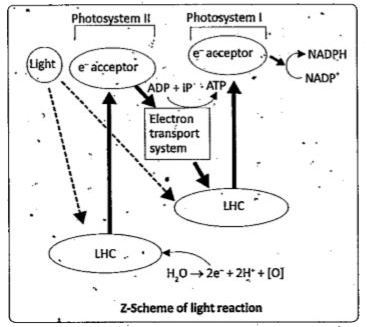What are the important events and end products of light, reactions? Solution in Telugu
In, light reaction important events are light absorption, water splitting, oxygen release and the end products are ATP and NADPH.
Light absorption : The molecules that absorb light are called pigments. The pigments are organised into two discrete photochemical light harvesting complexes (LHC) within the photosystem 1 (PS 1), and photosystem ll (PS II). Each photosystem has all the pigments forming a light harvesting system called antennae. The anterinae serves to absorb radiant energy. They.supply this energy finally to reaction centre: Reaction centre is chlorophyll .a. molecule. It converts light energy into chemical energy. The reaction centre in PS I is P700. The reaction centre in PS 11 is P680. Cyclic and Non-cyclic Photophosphorylation : The process of forming ATP by cells is named phosphorylation. As it is done in the presence of light, it is called photophosphorylation. It is of two types. 1).Cyclic photophosphorylation 2) Non-cyclic photophosphorylation.
1) Cyclic.photophosphorylation:
1) In cyclic photophosphorylation only PS I is functional. The electron is circulated within the photosystem and the phosphorylation occurs due to cyclic flow of electrons.
2) It takes place in stroma lamellae.
3) The electrons in the reaction centre of PSI gets.excited when they receive red light of wave length 700 nm.
4) In this process, the electrons from the reaction centre of PS 1 are conveyed to e acceptor.
5) The excited electron is cycled back to PS I through electron transport system.
6) The cyclic flow results in the synthesis of ATP.
2) Non-cyclic photophosphorylation :
1) When the two photosystems work in a series, first PS. II and then PSI a process called non-cyclic photophosphorylation occurs.
2) In PSII, the reaction centre chlorophylla absorbs 680 nm wavelength of red light causing electrons to become excited and jump.
3) The electrons are picked up by an electron acceptor.
4) From there it passes through electron transport system consists of cytochrome and reaches PSI.
5) Simultaneously electrons in the reaction centre PS I also gets excited when they receive red light of 700 nm wavelength.
6) The electrons from the PS I are conveyed to e acceptor.
7) These electrons then are moved downhill again, to a molecule of energy rich NADP+.
8) The addition of these electrons reduces NADP to NADPH+H. Non-cyclic photophosphorylation is also called Z-scheme.
Splitting of water :
1) The electrons that are moved from PS II are supplied with electrons continuously by.splitting of water.
2) The electrons removed from PS I are provided by PS II.
3) Water splitting complex (oxygen evolving complex) is responsible for photolysis of water.
Thus oxygen released is one of the net products of photosynthesis.
The end products of light reactionare ATP, NADPH and

Topper's Solved these Questions
- MODEL PAPER -13BOOK - VGS PUBLICATION-BRILLIANTCHAPTER - MODEL PAPER -13EXERCISE - SECTION -B
8 Videos
- MODEL PAPER - 6BOOK - VGS PUBLICATION-BRILLIANTCHAPTER - MODEL PAPER - 6EXERCISE - SECTION - C
2 Videos
- MODEL PAPER -14BOOK - VGS PUBLICATION-BRILLIANTCHAPTER - MODEL PAPER -14EXERCISE - SECTION -C
3 Videos
Similar Questions
How does ascent of sap occur in tall trees ?
View SolutionWrite notes on the working of the heart of man.
View SolutionDefine transpiration. Explain the structure and mechanism of "opening and closing of stomata.
View SolutionWhat are the important events and end products of the light reactions?
View SolutionThe end products of light reaction are
View SolutionEnd product of light reaction is_____.
View SolutionWhat are the end products of light reaction of photosynthesis ?
View Solutionप्रकाश अभिक्रिया की महत्वपूर्ण घटनाएँ तथा अंतिम उत्पाद क्या होते हैं ?
View SolutionWhat are the assimilatory powers formed at the end of light reaction ?
View SolutionWhat are the end products of dark reaction ?
View SolutionWhat are the end products of light reaction ?
View SolutionName the end products of light reaction.
View SolutionWhat are the important events and end products of light reaction?
View SolutionWhat are the important events and end products of the light reactions?
View Solutionप्रकाश अभिक्रिया की महत्वपूर्ण घटनाएँ तथा अंतिम उत्पाद क्या होते हैं ?
View SolutionName the end products of light reaction of photosynthesis. Mention the fate of each of them.
View Solution
